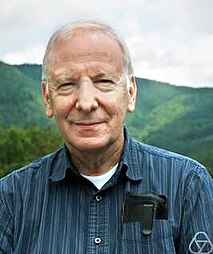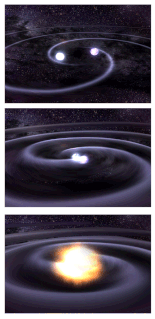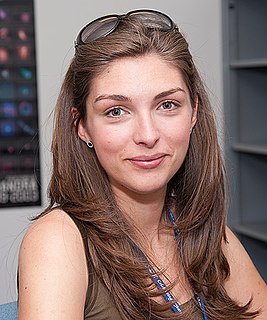Related Research Articles

Rainer "Rai" Weiss is an American physicist, known for his contributions in gravitational physics and astrophysics. He is a professor of physics emeritus at MIT and an adjunct professor at LSU. He is best known for inventing the laser interferometric technique which is the basic operation of LIGO. He was Chair of the COBE Science Working Group.

The Max Planck Institute for Gravitational Physics is a Max Planck Institute whose research is aimed at investigating Einstein's theory of relativity and beyond: Mathematics, quantum gravity, astrophysical relativity, and gravitational-wave astronomy. The Institute was founded in 1995 and is located in the Potsdam Science Park in Golm, Potsdam and in Hannover where it is closely related to the Leibniz University Hannover. The Potsdam part of the institute is organized in three research departments, while the Hannover part has two departments. Both parts of the institute host a number of independent research groups.

Robert M. Wald is an American theoretical physicist who studies gravitation. His research interests include general relativity, black holes, and quantum gravity. He is also a science communicator and textbook author.

Gravitational-wave astronomy is an emerging branch of observational astronomy which aims to use gravitational waves to collect observational data about objects such as neutron stars and black holes, events such as supernovae, and processes including those of the early universe shortly after the Big Bang.

Alessandra Buonanno is an Italian naturalized-American theoretical physicist and director at the Max Planck Institute for Gravitational Physics in Potsdam. She is the head of the "Astrophysical and Cosmological Relativity" department. She holds a research professorship at the University of Maryland, College Park, and honorary professorships at the Humboldt University in Berlin, and the University of Potsdam. She is a leading member of the LIGO Scientific Collaboration, which observed gravitational waves from a binary black-hole merger in 2015.
The Gravitational Wave International Committee is a panel of gravitational wave detection Laboratory or Observatory directors that promotes cooperation and collaboration between the gravitational wave detector projects and provides direction and advice on the future development of the field. Barry Barish founded the GWIC in 1997 and served as the chair from 1997-2003.
Nergis Mavalvala is a Pakistani-American astrophysicist known for her role in the first observation of gravitational waves. She is the Curtis and Kathleen Marble Professor of Astrophysics at the Massachusetts Institute of Technology (MIT), where she is also the Dean of the university's School of Science. She was previously the Associate Head of the university's Department of Physics She was awarded a MacArthur Fellowship in 2010.
Multi-messenger astronomy is astronomy based on the coordinated observation and interpretation of disparate "messenger" signals. Interplanetary probes can visit objects within the Solar System, but beyond that, information must rely on "extrasolar messengers". The four extrasolar messengers are electromagnetic radiation, gravitational waves, neutrinos, and cosmic rays. They are created by different astrophysical processes, and thus reveal different information about their sources.

Vassiliki Kalogera is a Greek astrophysicist. She is a professor at Northwestern University and the Director of the Center for Interdisciplinary Exploration and Research in Astrophysics (CIERA). She is a leading member of the LIGO Collaboration that observed gravitational waves in 2015.
Manuela Campanelli is a distinguished professor of astrophysics and mathematical sciences of the Rochester Institute of Technology, and the director of their Center for Computational Relativity and Gravitation and Astrophysics and Space Sciences Institute for Research Excellence. Her work focuses on the astrophysics of merging black holes and neutron stars, which are powerful sources of gravitational waves, electromagnetic radiation and relativistic jets. This research is central to the new field of multi-messenger astronomy.
Maura McLaughlin Ph.D. is currently an astrophysics professor at West Virginia University in Morgantown, West Virginia. She holds a Bachelor's of Science degree from Pennsylvania State University and a Ph.D. from Cornell University. She is known for her work on furthering the research on gravitational waves and for her dedication to the Pulsar Search Collaboratory. She was named a Fellow of the American Physical Society in 2021.

Sheila Rowan is a Scottish physicist and academic, who is Professor of Physics and Astronomy at the University of Glasgow in Scotland, and director of its Institute for Gravitational Research since 2009. She is known for her work in advancing the detection of gravitation waves. In 2016, Rowan was appointed the (part-time) Chief Scientific Advisor to the Scottish Government.
Marica Branchesi is an Italian astrophysicist. Her leadership and scientific work was pivotal for Virgo/LIGO's discovery of gravitational waves. She is vice president of International Astronomical Union Gravitational Wave Astrophysics Commission and member of the Gravitational Wave International Committee.
Samaya Michiko Nissanke is an astrophysicist, associate professor in gravitational wave and multi-messenger astrophysics, and the spokesperson for the GRAPPA Centre for Excellence in Gravitation and Astroparticle Physics at the University of Amsterdam. She works on gravitational-wave astrophysics and has played a founding role in the emerging field of multi-messenger astronomy. She played a leading role in the discovery paper of the first binary neutron star merger, GW170817, seen in gravitational waves and electromagnetic radiation.

Eleonora Troja is an Italian astrophysicist. In 2017 she led the discovery of X-ray emission from the gravitational wave source GW170817. She is an associate research scientist at University of Maryland, College Park and Goddard Space Flight Center.

Rita M. Sambruna is an Italian-American astrophysicist and is the Deputy Director of the Astrophysics Science Division at National Aeronautics and Space Administration's (NASA) Goddard Space Flight Center. Sambruna held the Clare Boothe Luce Professorship in Physics and Astronomy at George Mason University.
Norna Robertson is a lead scientist at LIGO at California Institute of Technology, and professor of experimental physics at the University of Glasgow. Her career has focused on experimental research into suspension systems and instrumentation to achieve the detection of gravitational waves.
Beverly K. Berger is an American physicist known for her work on gravitational physics, especially gravitational waves, gravitons, and gravitational singularities. Alongside Berger's more serious physics research, she is also known for noticing that vibrational patterns caused by local ravens were interfering with observations at the Laser Interferometer Gravitational-Wave Observatory.
Gabrielle D. Allen is a British and American computational astrophysicist known for her work in astrophysical simulations and multi-messenger astronomy, and as one of the original developers of the Cactus Framework for parallel scientific computation. She is a professor of mathematics and statistics at the University of Wyoming.
Peter Reed Saulson is an American physicist and professor at Syracuse University. He is best known as a former spokesperson for the LIGO collaboration serving from 2003 to 2007 and research on gravitational wave detectors.
References
- ↑ "Alessandra Corsi, Ph.D.", Faculty, Texas Tech Department of Physics and Astronomy, retrieved 2022-07-25
- 1 2 Curriculum vitae (PDF), 25 May 2022, retrieved 2022-07-25
- ↑ "Fellows nominated in 2019 by the Division of Astrophysics", APS Fellows archive, American Physical Society, retrieved 2022-07-25
- ↑ Young, Glenys (4 December 2019), "Astrophysicist Recognized for Pioneering New Field of Multi-Messenger Astronomy", Texas Tech Today, retrieved 2022-07-25
- ↑ Young, Glenys (9 September 2021), "Alessandra Corsi Wins 2022 New Horizons in Physics Prize: She was honored for her groundbreaking work in multi-messenger astronomy", Texas Tech Today, retrieved 2022-07-25